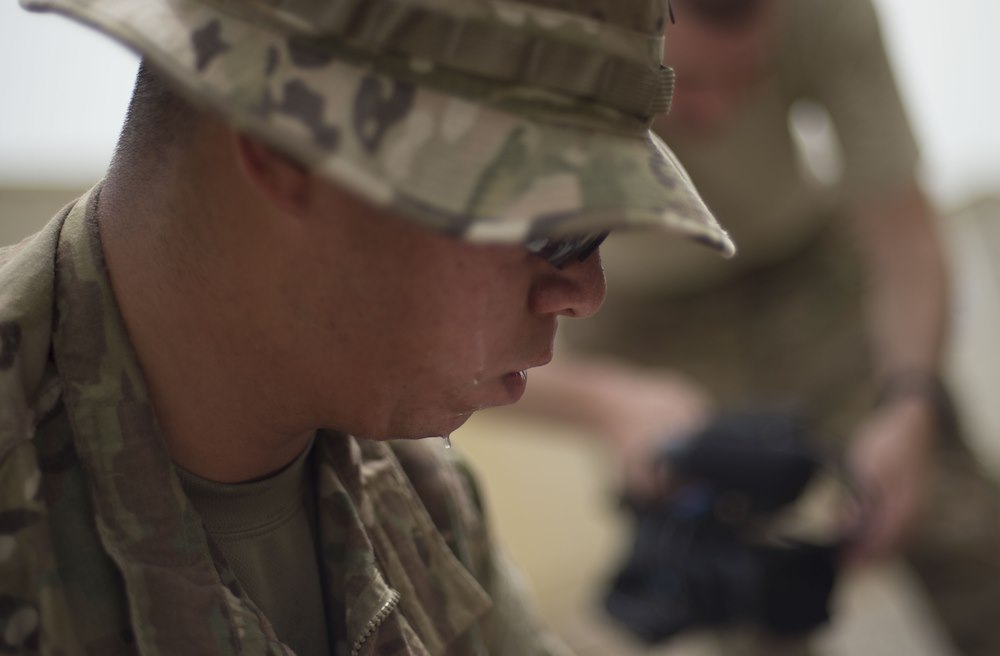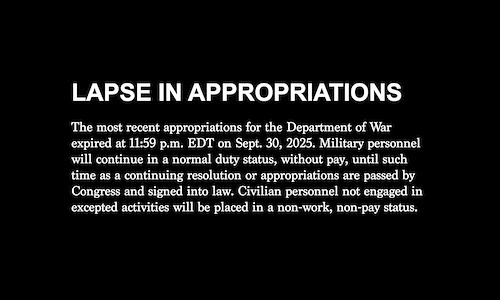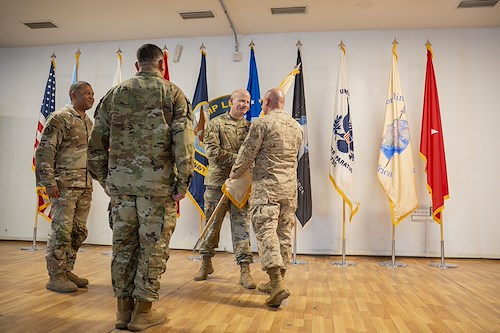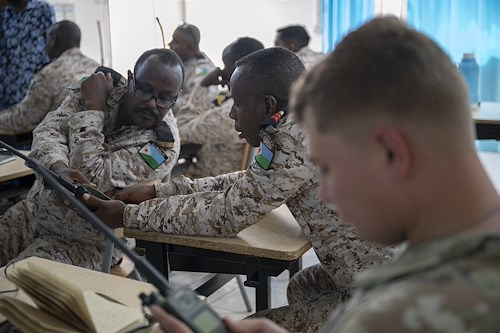Gallery contains 7 images
×
Photo 1 of 7
Combined Joint Task Force - Horn of Africa Image
U.S. Army Spc. Larry Martinez, 53rd Brigade Support Battalion, applies skills learned to a simulated casualty during the practical exam portion of a combat lifesaver course, June 23, 2016, at Camp Lemonnier, Djibouti. The Miami native, along with other classmates, learned about several basic procedures to stop blood loss and restore breathing to a wounded person. (U.S. Air Force photo by Staff Sgt. Eric Summers Jr.)
Photo by: Staff Sgt. Eric Summers Jr
Photo 2 of 7
Combined Joint Task Force - Horn of Africa Image
Simulated casualties lay on the ground before receiving treatment during a combat lifesaver course June 23, 2016, at Camp Lemonnier, Djibouti. The course taught the students basic skills that could potentially save lives on a battlefield. (U.S. Air Force photo by Staff Sgt. Eric Summers Jr.)
Photo by: Staff Sgt. Eric Summers Jr
Photo 3 of 7
Combined Joint Task Force - Horn of Africa Image
A student’s hand applies a dressing to a simulated victim during a hands-on portion of a combat lifesaver course taught June 23, 2016, at Camp Lemonnier Djibouti. The four-day course included 40 hours of instructional and hands on training to U.S. and French service members. (U.S. Air Force photo by Staff Sgt. Eric Summers Jr.)
Photo by: Staff Sgt. Eric Summers Jr
Photo 4 of 7
Combined Joint Task Force - Horn of Africa Image
Students check the vital signs of U.S. Army Staff Sgt. Kevin Kolessar, 403rd Civil Affairs Battalion, who played a simulated casualty during a combat lifesaver course, June 23, 2016, at Camp Lemonnier, Djibouti. Soldiers from the 403rd CA BN assigned to Combined Joint Task Force-Horn of Africa taught fellow service members and French military members how to potentially save a life. (U.S. Air Force photo by Staff Sgt. Eric Summers Jr.)
Photo by: Staff Sgt. Eric Summers Jr
Photo 5 of 7
Combined Joint Task Force - Horn of Africa Image
U.S. Army Spc. Kyle Davidson, 403rd Civil Affairs Battalion simulated casualty volunteer, receives a nasopharyngeal airway during a combat lifesaver course practical exam June 23, 2016, at Camp Lemonnier Djibouti. Soldiers from the 403rd CA BN assigned to Combined Joint Task Force-Horn of Africa taught fellow service members and French military members how to potentially say a life. (U.S. Air Force photo by Staff Sgt. Eric Summers Jr.)
Photo by: Staff Sgt. Eric Summers Jr
Photo 6 of 7
Combined Joint Task Force - Horn of Africa Image
Caporal-chef Adjudant, a French military medical officer, uses hand gestures to communicate with a simulated casualty during a combat lifesaver course practical exam June 23, 2016, at Camp Lemonnier, Djibouti. The French participants brought their own medical supplies to show how they treat patients. (U.S. Air Force photo by Staff Sgt. Eric Summers Jr.)w
Photo by: Staff Sgt. Eric Summers Jr
Photo 7 of 7
Combined Joint Task Force - Horn of Africa Image
CAMP LEMONNIER, Djibouti- French Capt. Xavier, physician, demonstrates the French medical supplies and how they are used during a combat lifesaver course, June 21, 2016, at Camp Lemonnier, Djibouti. Taught by soldiers from the 403rd Civil Affairs Battalion assigned to Combined Joint Task Force-Horn of Africa, this four day CLS course was the first to have French service members attend to learn and share medical skillsets. (U.S. Air Force photo by Staff Sgt. Tiffany DeNault)
Photo by: Staff Sgt Tiffany DeNault
When someone is injured and heavily bleeding, it is important to learn medical skills that may save that person’s life. This is especially important not only at home or work centers, but the battlefield as well.
Soldiers from the 403rd Civil Affairs Battalion from Mattydale, N.Y., assigned to the Combined Joint Task Force-Horn of Africa, taught fellow service members and French military members just that: how to save a life, limb and/or eyesight during a combat lifesaver course, June 20-23, 2016.
With support from the HOA Surgeon Cell, the four day course included 40 hours of instructional and hands-on training to soldiers from the 1st Battalion, 124th Infantry Regiment, and a French doctor, nurse and paramedic from the French military base in Djibouti.
“It’s mostly taught to help prevent the leading causes of injury and death on the battlefield such as bleeding control, airway management and treating for shock, hyperthermia, and getting (the patients) to a higher echelon of care,” said U.S. Army Sgt. Kathleen Greene, 403rd CA BA CLS instructor.
It was also the first time French military members attended the course to not only learn from the 403rd CA BN but to share their skill sets.
“I think it’s great. I’m sorry we don’t get to (participate) more,” said French Capt. Xavier, physician. “At the base, even though I’m a doctor, I learned a lot about (American) practices and about what they do in the field. I hope we get to do it again.”
The French team brought their own medical supplies to show how they treat patients.
“They brought in all of their medical supplies and showed us how they set up their Individual First Aid Kit (IFAK) as well as their A-bags,” said Greene. “The physicians also told us the training they have to do to have their jobs. They were just a big attribute to this class and taught us a lot about the French military.”
The course started with a pre-test to see where students were with their skills then were tested again at the end of the four days.
“We had a 100% success rate with the final hands-on skill set and the written (test),” said U.S. Army Spc. Kristie Richardson, 403rd CA BNCLS instructor. “Nearly half the class on the first day unfortunately failed (the test), but it just shows you how much they have learned throughout the four days in this course and it’s amazing.”
There were students with no medical experience who left with the desire to learn more, said Richardson.
“A lot of the combat wounds in the field can be prevented and a lot of deaths can be prevented with tourniquets. A lot of people have not seen a tourniquet or have used one,” said U.S. Army Spc. Larry Martinez, 1/124 Inf. Rgt. wheeled vehicle mechanic. “With this training we learned on tourniquets, dressing, splinting fractures, and calling in a 9-line (medical evacuation), so if you’re ever put into that position in the field you’re better familiarized with everything you have learned.”
The classroom and hands-on training gave the students critical skills to put in their “tool box” that will minimize unnecessary deaths and give them the experience and knowledge to use the supplies in the IFAK, or to improvise supplies, Greene said.
“I feel very lucky and fortunate to be an instructor for this course,” said Richardson. “I think it should be mandated [for] 100% for the branches. Being here at Camp Lemonnier and [being] able to provide this course to not just Army like it is in garrison, we get to provide it not only to marines, sailors, and airman but also to foreign allies as well.”


























